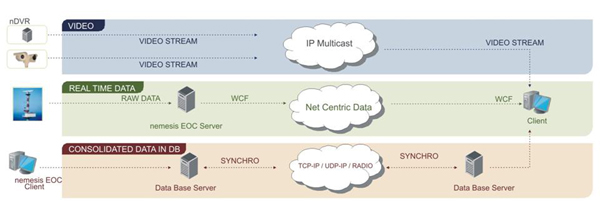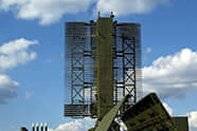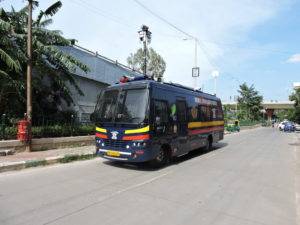A critical part of an emergency management process involves operating an Emergency Operations Center (EOC). An EOC is the physical location where an organization comes together during an emergency to coordinate response and recovery actions and resources. These centers may alternatively be called command centers, situation rooms, war rooms, crisis management centers, or other similar terms. Regardless of the term, this is where the coordination of information and resources takes place. The EOC is an operations center where coordination and management decisions are facilitated.
EOC Architecture
A properly designed Emergency Operations Centers serves as an effective and efficient facility for coordinating emergency response efforts. It can optimize communication and coordination by effective information management and exchange.
The nemesis EOC (EOC) from Mistral is an Emergency Operations Center developed by Amper; and is designed to be used in a HQ environment. It operates through a LAN/WAN, with a set of distributed services and applications based on a Service Oriented Architecture (SOA) design and Web-service paradigm.
The EOC solution synchronizes Situational Awareness during a crisis by sharing operational information in real-time, ensuring its relevance and timeliness. The consolidated information, called the Common Operational Picture (COP); flows horizontally, among the various agencies involved, and down, to the operational units. The EOC is a multi-operation system and allows command and control of several operations at the same time. It is multi-domain: ready for information exchange with other systems and mass-media to facilitate collaborative work in the command centers. It also includes a Human-Machine-Interface (HMI) created for intuitive use, like any standard Web application.
 |
|---|
| nemesis EOC Multi-operation Multi-domain Concept |
The key features of the EOC solution are as follows:
- Network Enabled command and control system for full crisis management
- Capability to integrate different types of communications, video, sensors, action protocols, etc. within the system
- Interoperability: Standard database JC3IEDM model that provides interconnection with legacy systems
- Common Operational Picture of the emergency: COP distribution and Situational Awareness
- Synchronization, horizontally among agencies involved and throughout the operational chain
- Collaborative work environment: Data Exchange among all levels, inter & intra-agencies
- Object –Oriented and Distributed Architecture, Web Service Paradigm
Some of the key functionality provided by the Emergency Operations Center (EOC) Solution is listed below:
Global Crisis Management
By interacting with legacy systems of involved agencies and deployed mobile units, the EOC provides a complete overview of the crisis situation. The EOC uses the data model standard, JC3IEDM to enable this and provides an XML-based web interface to easily capture all important information in a crisis situation.
 |
|---|
| JC3IEDM Replication Multilateral Interoperability Programme |
Publish/Subscribe Mechanism
The sensor data is managed by Publication/Subscription mechanisms. An operator can subscribe to the information or services offered by the EOC and its sub-systems. The EOC solution incorporates a middleware layer in charge of searching for the information and distributing it to subscribers. The information received is consolidated into the database in real-time.
The decentralized and open architecture of the EOC works independent of the sensors and other sub-systems, allowing the system to be managed from any fixed or mobile network point, providing an added level of robustness in case of failures and disaster situations.
Applications and Tools
The EOC integrates a set of applications and necessary tools to manage every aspect of crisis situation covering:
- Operation Planning
- Interactive GIS
- Communications Management
- Mobile units follow-up (terrestrial, maritime, aerial)
- Special operations management
- Logistics management
- Management system tools
Conclusion
A well-designed EOC can greatly aid response coordination and recovery of activities. Clear operating procedures, staff roles, and responsibilities are required as is an effective workspace and a safe location. Above all, it requires a full-fledged Emergency Response management system that can handle full crisis management at strategic, operational and tactical levels from a central command and control environment.



